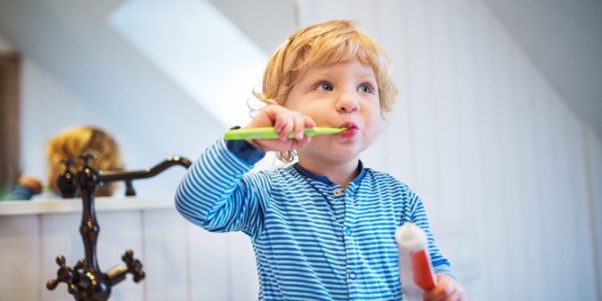Understanding your child’s tooth development
Watching your child grow is full of exciting firsts. Whether it’s taking their first steps, saying their first words, or losing their first baby tooth. Your child’s teeth develop at their own pace and can vary from one child to another. But there are some key stages to be aware of. In this article, we’ll guide you through an average timeline of your child’s tooth development, so you know what to expect.

Six months to three years
When your baby is around six months old, their very first tooth will usually emerge from inside their gum. These early teeth are often called baby teeth or milk teeth.
The bottom front teeth are usually the first to erupt, followed by the top front teeth. These are known as central incisors. The teeth on either side of these usually come in next, which are called lateral incisors. Next up, is the first set of back teeth – known as the first molars. The sharp canines that frame the front of their mouth appear next, and finally, the second set of molars come in.
During this time, you might notice that your little one’s cheeks are red or warm. They could start to dribble more than usual too. You might find it helps to rub a special teething gel onto their gums or give them a cool (not frozen) teething ring to chew on.
As soon as your child’s first tooth appears, you should begin cleaning their teeth. Use a small soft toothbrush and a smear of toothpaste containing at least 1,000ppm of fluoride until they turn three.
It’s also a good time to introduce your child to regular check-ups at the dentist. Early visits can help them get used to the sights and smells of the dentist from an early age. Your dentist can also give you advice on how to care for your child’s teeth.
Three to six years
By the time your little one is three years old, they should have all 20 of their baby teeth. These tiny teeth will stick around for the next few years. They help your child to eat, speak, and hold space for the adult teeth to grow into, so it’s important to keep them clean.
Around this age, start using a pea-sized amount of toothpaste with 1,350 to 1,500ppm of fluoride. You can begin encouraging your child to learn how to clean their own teeth, but keep doing it with them until they’re at least seven.
6 to 14 years
When your child is around six years old, the first of their permanent adult teeth – the back molars – will begin to erupt. These are important for your child’s future tooth development. When they first come through, the enamel isn’t fully hardened yet, so molars need to be cleaned carefully. Sometimes, your dentist will put a protective coating (sealant) onto the biting surfaces to protect them.
Soon after, you’ll need to plan for a visit from the tooth fairy, as their baby teeth will start to wobble and fall out. This usually starts around the age of six to seven. The bottom front teeth are usually the first to go, followed by the top front teeth.
From here, your little one will continue to lose their baby teeth and grow permanent ones. By age 12 to 14, most children have 28 adult teeth. The final four wisdom teeth usually come in later.
Late teens and early twenties
During their late teens and early twenties, your child’s third molars – commonly known as wisdom teeth – may come through. These teeth typically erupt between the ages of 17 to 25, though not everyone develops them. If your child’s wisdom teeth do emerge, they’ll have a full set of 32 permanent adult teeth.
-
Sources Sources
- A practical guide to children’s teeth. British Society of Paediatric Dentistry. www.bspd.co.uk, accessed June 2025
- Teething: At what age does teething occur? NICE Clinical Knowledge Summaries. cks.nice.org, last revised October 2024
- Dental care for mother and baby. Oral Health Foundation. dentalhealth.org, accessed June 2025
- Children’s teeth. Oral Health Foundation. dentalhealth.org, accessed June 2025
- Oral health. Department for Education. help-for-early-years-providers.education.gov.uk, updated December 2024
- Wisdom teeth. Oral Health Foundation. dentalhealth.org, accessed June 2025
About our health information
At Bupa we produce a wealth of free health information for you and your family. This is because we believe that trustworthy information is essential in helping you make better decisions about your health and wellbeing.
Our information has been awarded the PIF TICK for trustworthy health information. It also follows the principles of the The Information Standard.

More general health advice articles
Did you find our advice helpful?
We’d love to hear what you think. Our short survey takes just a few minutes to complete and helps us to keep improving our healthy lifestyle articles.
Legal disclaimer
This information was published by Bupa's Health Content Team and is based on reputable sources of medical evidence. It has been reviewed by appropriate medical or clinical professionals and deemed accurate on the date of review. Photos are only for illustrative purposes and do not reflect every presentation of a condition.
Any information about a treatment or procedure is generic, and does not necessarily describe that treatment or procedure as delivered by Bupa or its associated providers.
The information contained on this page and in any third party websites referred to on this page is not intended nor implied to be a substitute for professional medical advice nor is it intended to be for medical diagnosis or treatment. Third party websites are not owned or controlled by Bupa and any individual may be able to access and post messages on them. Bupa is not responsible for the content or availability of these third party websites. We do not accept advertising on this page.




